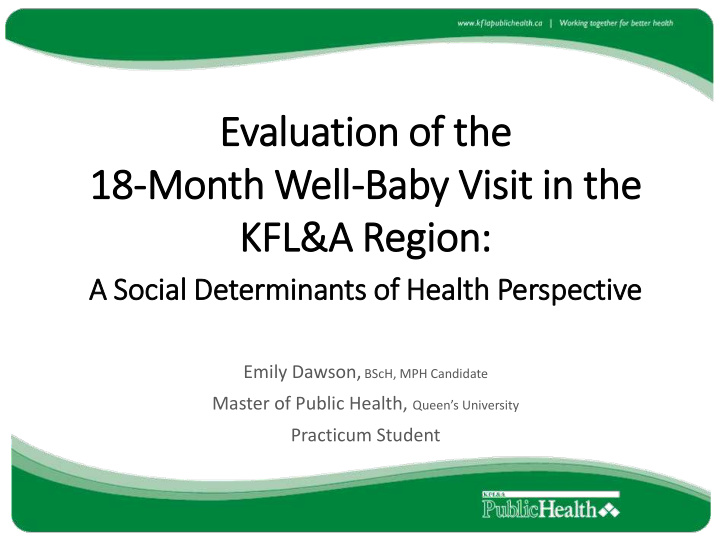



Evaluation of f the 18 18-Month Well-Baby Visit in the KFL&A Region: A Socia ial l Determinants of Healt lth Perspectiv ive Emily Dawson, BScH, MPH Candidate Master of Public Health, Queen’s University Practicum Student
Conflict of Interest Disclosure Presenter Disclosure • Presenter: Emily Dawson • Relationships with commercial interests: • Grants/research support: none • Speakers Bureau/Honoraria: none • Consulting fees: none • Other: none
Disclosure of Commercial Support This program has received financial support from: The Ontario Medical Association and KFL&A Public Health This program has received in-kind support from: KFL&a Public Health Potential for conflicts of interest: None
Mitigating Potential Bias • There is no potential bias in this program
Background The 18-month visit: recognized as a pivotal visit in the scheduled primary care provider contacts prior to school entry • Discussion with parents on healthy development and concerns • Provide parents with information on community resources • Timely facilitation of referrals • Uses standardized tools to assess development
Enhanced 18-month Well ll Baby Vis isit it (E (EWBV) • patient between the ages of 17 and 24 months of age. • Services of a standard well baby care visit • An 18-month age-appropriate developmental screen such as the Rourke Baby Record • Review of a standardized tool, completed by the caregiver, such as the Nipissing District Developmental Screen • Recorded in the patient’s permanent medical record
Background 2005: “ Getting it Right at 18-months... Making it right for a lifetime. ” 2009: the Ontario Medical Association and Ontario Ministry of Health and Long-Term Care introduced new fee codes for the Enhanced 18-Month Well-Baby Visit (EWBV) 2011: “Uptake of the New Fee Code for Ontario’s Enhanced 18-Month Well-Baby Visit: A Preliminary Evaluation”
Project Obje jectives • Collaborative relationship between Primary Care and Public Health • Provide longitudinal assessment of the EWBV through annual audits • Assess health service equity • All children provided with an equal opportunity to succeed
Enhanced 18-Month Well ll-Baby Vis isit it Audits 2012 : • Three family health teams/community health centres • Audit: January 1, 2010 to December 31, 2011 • Audited use of billing codes/ billing code equivalencies 2013 : • Follow up audits: October 1, 2012 to March 31, 2013 • Two new partners for the initial audit • Manual chart audit of the EMR
Enhanced 18-Month Well ll-Baby Vis isit it Audits 2014: • Follow up audits for 5 previous practices • Audit from April 1, 2013 to March 31, 2014 • Initial audit for 1 new primary care partner • Audit from April 1, 2012 to March 31, 2014 • Manual chart review of EMR
Methods • Meeting between KFL&A and Primary Care Partner • Data collection through EMR queries and manual chart review • Data analysed using excel software and GIS data • Social determinants and equity evaluated by • INSPQ Deprivation Index • Dissemination Area
Methods OHIP Number Completion of EWBV Date of Birth RBR use Postal code Date of EWBV NDDS use Use of RBR A002A Billing Codes Completed sections of RBR Referrals Use of NDDS Immunization details 18-month Referral and recommendation details Immunizations Provider classification Relevant supplementary details
Results The implementation rate of the EWBV and 18 month immunizations for the KFL&A region in the 2013 audit and 2014 audit of primary care practices 100 90 80 Percent Complete 2013 Audit 70 60 2014 Audit 50 40 30 20 10 0 EWBV DTaP-IPV-Hib
Results The implementation rate of standardized tool use and referrals made during EWBVs for the KFL&A region in the 2013 audit and 2014 audit of primary care practices 100 90 Percentage Complete 80 70 2013 60 Audit 50 40 2014 30 Audit 20 10 0 RBR NDDS Referrals A002A Specific measures of visit quality
Analysis Implementation rate of the enhanced well baby visit and 18 month immunizations for eligible patients organized by combined deprivation rank 100 90 80 Percentage Complete 70 60 50 40 30 20 10 0 V- Most Deprived IV III II I- Least Deprived Combined Material and Social Deprivation Rank EWBV DTaP-IPV-Hib 2 per. Mov. Avg. (EWBV) 2 per. Mov. Avg. (DTaP-IPV-Hib)
Case Study Early Development Instrument (EDI) • measurement of school readiness • 5 areas of child development • Measure of a population not individual children Assess EWBV implementation across populations with different levels of vulnerability according to EDI score
Case Study EWBV implementation rate for eligible patients across populations with increasing vulnerability in one or more domain of the EDI 100 Percent of population with an EWBV 90 80 70 60 50 40 30 20 10 0 6-14% 15-23% 24-31% 32-41% 42-52% Percent vulnerable in one or more domain using the early development instrument
Future Directions • Include additional primary care partners in the project • Continue providing a longitudinal assessment of the EWBV • Focus on a comprehensive visit • Further the analysis of EWBV through a social determinants lens • Early Development Instrument
Future Directions • Enhanced Well Baby Assessment in Primary Care seminar • Continue to promote the use of the EWBV Quality Improvement Plan Toolkit • Provide resources and support to assist in conducting a comprehensive
Acknowledgements…
Recommend
More recommend